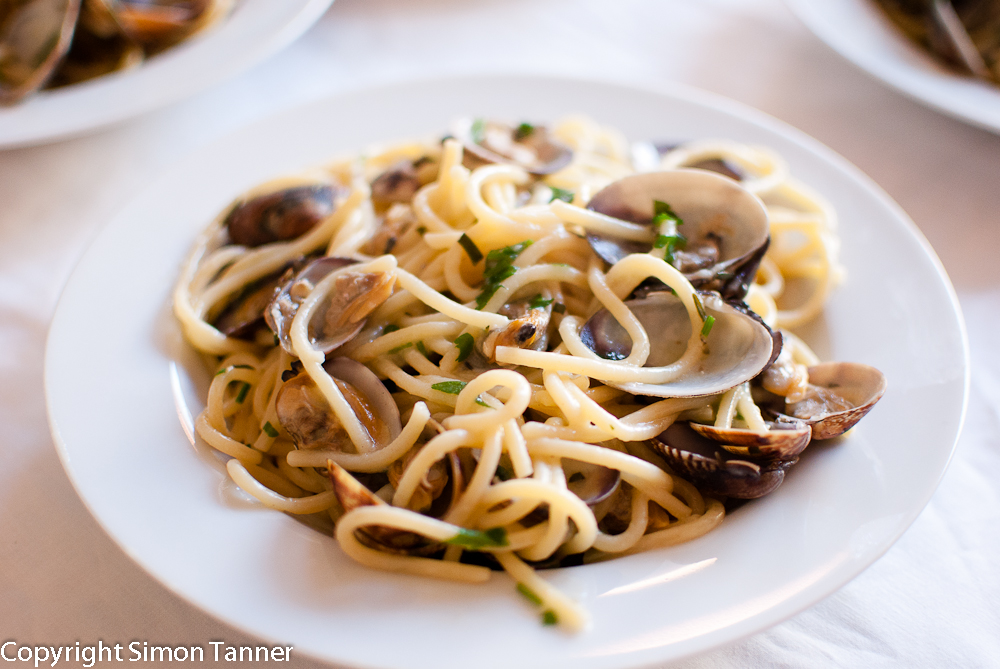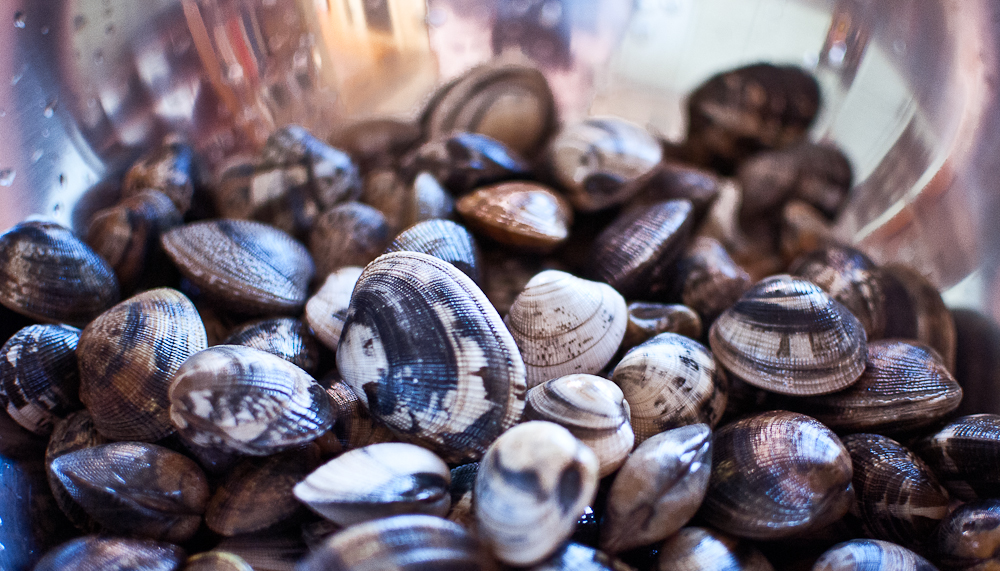Read this post in / Anche disponibile in: Italian
 This is not specifically a Sicilian dish, and other regions of Italy have their own versions (although variation is minimal). Anyway, it’s served in most seafood restaurants here, and is a favourite in my house, and that’s good enough for me.
This is not specifically a Sicilian dish, and other regions of Italy have their own versions (although variation is minimal). Anyway, it’s served in most seafood restaurants here, and is a favourite in my house, and that’s good enough for me.
This is one of those dishes that I always feel has something of a restaurant aura about it, but I suspect this is simply a hangover from my English upbringing. Anything served in its shell (even mussels or crab, let alone the heights of lobster and oysters) was bordering on the exotic, and while we may have eaten them on holiday in France, back home in Blighty I don’t remember having ever removed even a prawn from its shell. Seafood was either steamed or boiled naked, or coated in breadcrumbs or batter and fried. In fact, I suspect I was not alone in thinking that scampi were actually born in breadcrumbs. Worst of all was the fish that was left to soften in oil and dodgy tomato sauce and then, seemingly out of sheer bloody-mindedness, canned. Yes, I’m talking about pilchards. God, they were evil. Do they still sell those things? Or have people given them up for something more pleasurable, like self-flagellation?
Thankfully, things have changed, but nevertheless, food that has so obviously just been plucked from the sea, that is still alive and hiding in its shell, still smacks of luxury, almost Neronian decadence. But despite all that, the good news is that this a dish you can do real justice to at home. One of the secrets – which of course isn’t really a secret at all – is to use the best olive oil you can find, since it’s such a substantial part of the sauce.
There are two main versions – with tomatoes, or in bianco (without them). I prefer the latter, so that’s what you’re getting. On the rare occasions I feel like putting them in, I add a couple of nicely ripe, diced, seeded tomatoes, but only for the last minute or so of cooking, so that they don’t fall apart and become a sauce.
The other variants are merely tweaks to the list of ingredients, and I’ve listed them as options below. The first is chilli. I recommend it, not solely because I’m an addict, but because its spicy heat counterpoints the sweetness of the clams. This is also the most widely used additional ingredient, and indeed is considered essential by many. Then we move on to the more controversial contenders. Butter, for example. There’s no doubt that a bit of butter makes the sauce silkier and creamier, but I’m not sure that’s really what I want with clams. I’ve tried it, but it’s not for me. I prefer the cleaner, fresher taste of grassy olive oil with my seafood. Rosemary, on the other hand, while not traditional, definitely works, providing a woody, balsamic note that combines perfectly with the garlic-infused clam juice.
One thing all the best recipes agree on is the importance of draining the pasta before it’s fully cooked. This allows it to be finished in, and thus absorb, the intensely-flavoured sauce resulting from the liquor released by the clams, the wine and the herby, garlicky oil.
A plate of this and a chilled bottle of Grillo is a marriage made in heaven, especially if you can get any of Tasca d’Almerita’s from the island of Mozia, which has an attractively mineral, saline edge to it, as well as the floral aromas typical of the variety.
- 1 kg clams, shells and all
- 400g spaghetti
- 2 cloves of garlic, peeled and sliced finely
- small bunch of parsley, finely chopped
- 3 tablespoons of extra virgin olive oil
- 100 ml dry white wine
- 1 tablespoon of chopped fresh rosemary (optional)
- a good pinch of chilli flakes (optional)
- a good knob of butter (optional)
- sea salt and freshly ground black pepper
- Wash the clams well, discarding any that are open and have no intention of closing up again when prodded.
- Put your pasta on to cook in plenty of salted boiling water, calculating two minutes less than the time given on the packet. Use a large pan with a lid (which you’ll be needing later on).
- While the pasta is cooking, gently sweat the garlic in a pan over a low heat for a couple of minutes in the olive oil, together with the chilli and/or rosemary if using. Remove from the heat. This is the time to stir in the parsely, and the butter, if you’re going for that option.
- Reserve a good ladleful of the pasta cooking water, then drain the partly cooked pasta.
- Put the empty pasta pan back on the heat, adding the clams, the wine, and the drained spaghetti. Season well with salt and pepper. Put the lid on and cook over a medium heat for a couple of minutes, shaking every so often, until the clams have opened.
- Remove the lid, then add the oil and herbs to the pasta. Cook for another minute or so until the pasta is cooked, but still al dente, adding some of the reserved pasta water if it looks like the sauce is disappearing.
- Divide between the plates, making sure that everyone gets their scant spoonful of the wonderful juice that has collected at the bottom of the pan.
And don’t forget to put a large plate in the middle of the table where everyone can dump their empty clam shells.

 English
English Italiano
Italiano